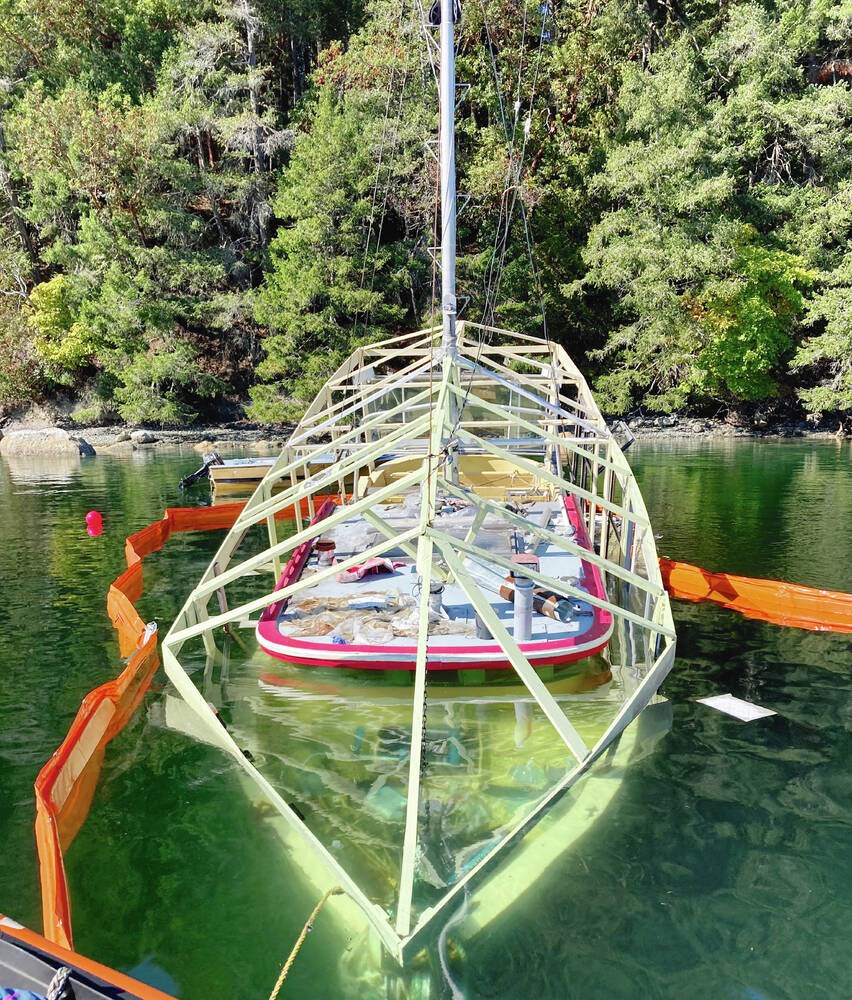With close to 1,600 abandoned and derelict boats reported to be in the waters around B.C., the Canadian Coast Guard is asking for patience from boaters and others as it works to enforce the two-year-old Wrecked, Abandoned or Hazardous Vessels Act.
Before July 2019, when the act came into effect, it was legal and common to abandon a boat along Canada’s 243,042 kilometres of coastline.
Robert Brooks, national director of the vessels of concern program for the Canadian Coast Guard, said the act “brought a lot of clarity.”
“For the first time, we had the enforcement powers — while working collaboratively with owners — to remove a boat if we determined that it posed a hazard to safety, navigation, property, community or a threat to the marine environment,” he said.
He described the act as a legal framework that sets out the rights, obligations and liabilities of boat owners. For the first time, it required boats of more than 300 gross tonnes to carry insurance on the chance they could become a hazardous wreck in Canadian waters. “Until then, a ship’s owner could legally just abandon her,” said Brooks, who is based in Ottawa.
While the Wrecked, Abandoned or Hazardous Vessels Act gives the coast guard the power to prosecute owners, its track record so far has been called into question by some.
Michael Simmons, vice-chair of the Saanich Inlet Protection Society, called the act a step in the right direction, but said the group forwarded a list of six boats of concern to the coast guard this year, and it didn’t act on any. “It seems the only time they act is after the boats have sunk.”
At least three of the six boats on the list have sunk.
Brooks said the coast guard is aware of the boats in Brentwood Bay, but each boat brought to its attention undergoes a risk assessment that considers more than 100 factors to determine what should be done.
The first step is to work with vessel owners to try to get them to comply. “We have been able to come to a successful conclusion in the majority of cases, but there are a few boaters who are not in a financial position to take care of their boat and are forced to abandon them.”
In each case, the coast guard has to follow due process as it investigates and that takes time, he said.
“We understand that everyone wants to see action immediately. But we have to prioritize our files, and unless it is actively polluting, we will follow up on a call as soon as we can.”
He said Canada has about 2,000 vessels reported as wrecked or abandoned at any given time. Reports tend to spike after high tides and extreme weather.
The 1,600 vessels in B.C. waters reflect a higher pleasure-boat ownership population on the West Coast, Brooks said.
The cost to remove a seized small pleasure craft from the water and dispose of it ranges from $5,000 to $25,000, he said, while refloating a larger vessel — especially if it is laced with pollutants and contaminants such as bunker fuel and asbestos — can cost up to $25 million.
Before the legislation, abandoning a boat was an attractive option for any boat owner facing hefty cleanup bills, Brooks noted.
While the taxpayer is on the hook for cleanup costs for now, plans are in the works by various levels of government to have the program owner-financed, he said.
“There is a broad range of considerations we are keeping in mind — but I can say that we are undertaking to create a plan that will address the cost of the program,” said Brooks. “As it is right now, it is an unfair burden on all taxpayers.”
There are two funding programs for removal and disposal of high-priority abandoned and wrecked vessels:
• Transport Canada’s Abandoned Boats Program: tc.canada.ca/en/programs/funding-programs/abandoned-boats-program/abandoned-boats-program-approved-projects
• Fisheries and Oceans Canada’s Small Craft Harbours Abandoned and Wrecked Vessels Removal Program, which provides funding to harbour authorities and other eligible recipients to remove and dispose ofabandoned and wrecked vessels located in federal small craft harbours. Go to dfo-mpo.gc.ca/sch-ppb/vessels-bateaux/index-eng.html
Canada’s domestic oil-spill compensation fund is the Ship-source Oil Pollution Fund, which is paid for by industry. The fund provides compensation for oil-pollution damage caused by any type of oil spill fromany type of vessel, even when the cause of the spill is not known. Once a claim is assessed and paid, the administrator of the fund will try to recover compensation from the polluter.
For more information on marine liability, go to tc.canada.ca/en/marine-transportation/marine-safety/marine-liability-compensation-oil-spills or the Ship-source Oil Pollution Fund website at sopf.gc.ca.



